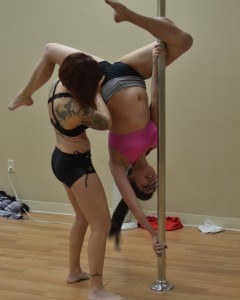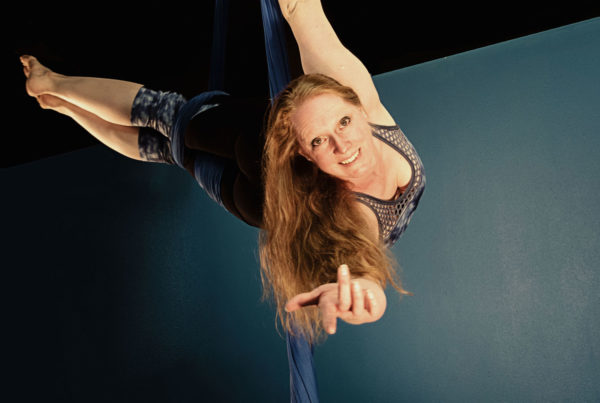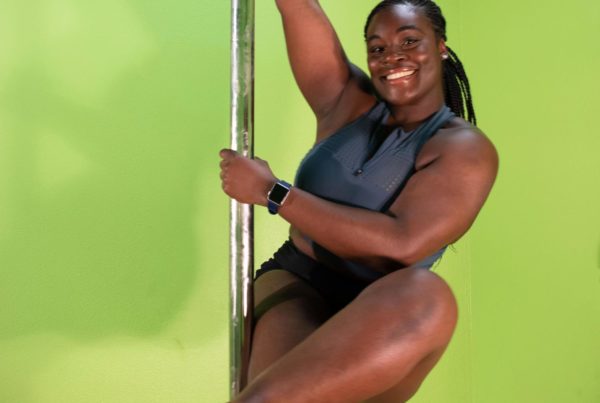
Pole and aerial classes have become the new fad of the fitness industry. I love these activities, so I am excited that more people are looking into these unique classes for fitness purposes. I have realized, unfortunately, that many students are focused on learning tricks quickly and “collecting” as many tricks as possible in a short period of time instead of focusing on the art as a whole. I call this “quick trick training” and many studios cater to this kind of instruction. The trend of instructors accommodating this mind set is dangerous to the student’s health and safety. It opens the door for injury, loss of the true art form, and can truly be risky.
Longevity
Students and teachers alike need to be dedicated to prolonging the athlete’s ability to participate in the activity for decades by preventing injury and promoting the proper training methods. Longevity based training is not just focused on how many moves you can learn quickly, but training focused on being able to do a sport or activity for a life time. To do a sport or an extremely physical activity long term, one must focus on strength, muscle balance, flexibility, injury prevention, and in the case of activities such as pole or aerial silks, it should include the ability to put combinations together in an artistic way to create a true art form as well as learning “cool tricks”.
The difference in these two teaching concepts is night and day. The “quick trick” curriculum caters to the student who does not understand the danger of injury or the need for the technique, strength, and flexibility necessary to perform each move. This curriculum style is the facility’s way of keeping the students happy and paying. In the end, however, the student is at greater risk of injury.
Health and Wellbeing
A longevity based program understands that students are excited to learn new skills, but channels that excitement towards a focus on their health and wellbeing. There are many components to long term athletic performance, especially in more extreme activities such as aerial arts and pole sport. There are many levels of technique, strength, and flexibility needed to complete certain skills. Conditioning and stretching (safely) as part of the regular curriculum is essential in creating competent athletes. Allowing students to work on skills before they have the strength or flexibility to do so, however, is setting the student up for an injury. It may not happen every time but it will happen eventually. It could be a minor muscle pull, but in these activities, it could mean a major life changing injury to the head, neck or spinal cord. Injuries happen even in the best of training environments, but the idea is to keep them to a minimum so that the student can continue to grow as an artist for years to come.
Aesthetic
The second reason for longevity based training is aesthetic. Weak artists create weak lines and skills. It is always more pleasing to perform  something less difficult but to do it properly with beautiful lines. It is also valuable to be able to create and execute combinations and choreography with grace. If students are just learning trick after trick, they will not understand how to put these skills together in a way that is pleasing to the audience, learn the inherent art of musicality, or stage presence. All of this, waters down the art. Makes it less appealing and entertaining. With that, its popularity begins to wane.
something less difficult but to do it properly with beautiful lines. It is also valuable to be able to create and execute combinations and choreography with grace. If students are just learning trick after trick, they will not understand how to put these skills together in a way that is pleasing to the audience, learn the inherent art of musicality, or stage presence. All of this, waters down the art. Makes it less appealing and entertaining. With that, its popularity begins to wane.
I understand the new student’s excitement and desire to learn everything there is to learn, RIGHT NOW! I, also, recognize that they are inundated with gratuitous amounts of tricks and skills every day on social media sites. This creates a desire for learning. That is not a bad thing. It is the instructor’s job, however, to insure the health and safety of the student first and foremost. We must say, “I understand your excitement, but I am resolute in protecting your wellness.” As students, you must realise that many skills may require physical elements that you have not achieved yet. You must be resolute in protecting your own safety as well.



